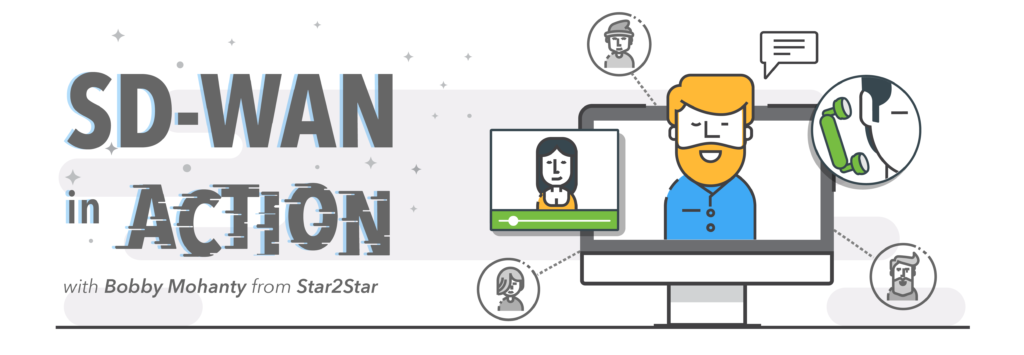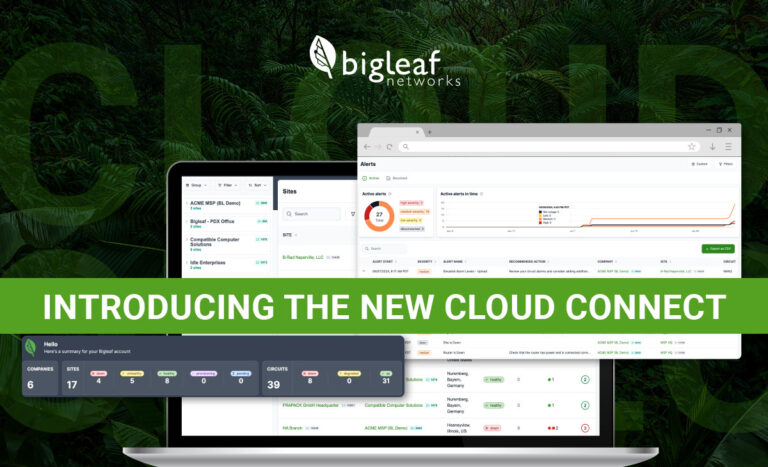For this month’s SD-WAN in Action, we’re talking with Bobby Mohanty, the Chief Product Officer for Star2Star Communications. Star2Star provides mid-market customers with a full spectrum of unified communication solutions. Depending on the size of the customer, the customer’s needs, maturity level and scale, Star2Star delivers its complete UC solutions through premise, cloud and hybrid deployments.
We recently spoke with Bobby to learn more about Star2Star’s customers, the unique challenges they face as they move to cloud-based UC solutions, and how SD-WAN is helping make that cloud journey more successful.

Q: So, what does the average Star2Star customer look like?
Bobby: When you look at the market we service, there are three to four broad segments, all of which fit into what most would refer to as the mid-market.
At one end of the spectrum of those segments are companies that would be classified as large companies — enterprises in the classic definition — though they may not look a lot like the traditional enterprises we know. They may have hundreds or thousands of locations where they use our solutions to deliver and reach out to their customers and interact. Retail is a great example of this kind of business. We’d refer to them as Distributed Enterprises.
They are enterprises in terms of thought process and business maturity, but at a given location they are very much an SMB.
At the other end are true SMBs. One and two site companies across any vertical market.
Between those two extremes is a growing segment of mid-sized companies. They have hundreds or thousands of employees across 50-200 locations.
Q: How do their requirements differ?
Bobby: All of these segments are moving to the cloud. The differences lay in the resources they have availability and the importance of those cloud technologies to the company.
If you go on the small biz side, that’s very much a cloud play. Connectivity and reliability of that internet connection are critical. When you come into the middle of that spectrum, connectivity and reliability are still critical, but you now have a need for greater resilience and uptime – things that have a real dollar impact on the company. And if you go to the far left of that spectrum, the requirements are very similar in nature, but there’s now a cost factor because you are deploying solutions across a much greater footprint.
Q: When you think across that spectrum, are you seeing trends in cloud adoption at those various levels?
Bobby: In certain scenarios, we’re seeing customers push to go to the cloud as fast as possible. We’ve also seen some hesitancy among some segments of the market worried that leaving on-premise behind might affect quality.
As you go up the market, the cloud is better understood, and customers have more resources and sophisticated IT departments.
In the UC space, the move to the cloud has been going on for multiple years. It’s a given. The low end has already moved. The mid-market acceleration rate has increased over the past couple of years.
Q: What’s driving that acceleration?
Bobby: As on-premise solutions are coming to end of life or requiring major support, that’s triggering the move for many companies. As PBXs reach those trigger points, customers are no longer holding out. They’re moving into a UCaaS, cloud and SaaS model.
The cloud is exposing the hidden enterprises. Companies with enterprise aspirations but an SMB IT staff.
Q: Relative to the move people are making, what are the big objections that you are seeing in the market when those conversations are happening?
Bobby: When you get into those, it’s typically not a tradeoff between I want a PBX or I want a UCaaS. They’ve already made a decision that they want to look at a cloud provider. The question is now which provider. In the mid-market, the reseller plays a huge role. The customer is depending on their knowledge and experience.
It’s no longer just answering a phone call. Now that same network connection is handling things like your customer service notifications. This underscores the need for a company’s infrastructure to be robust and reliable because things other than a phone rely on it. Things the company couldn’t do before, like provide support across voice, chat and social. Our customers aren’t only moving to the cloud to do cloud based solutions, they’re adding things to their business that rely on their network functioning properly.
What we do is solve business problems. That’s really what our customers come to us to help them with.
Q: What are some of these new use cases?
Bobby: It’s not that some of these things could not have been done or weren’t available. They weren’t integrated. And they required a level of expertise not commonplace in many of these hidden enterprises. They were separate, individual solution stacks that brought inherent costs with them. Working with Bigleaf, we’re able to properly integrate and package those components into integrated solutions.
For example, we rolled out a 4G solution. It’s been an absolute hit with our customers. It’s a networking solution, but it’s providing a backup capability customers need. We’re able to deliver it as a single solution set. It’s a big differentiator for us. If a customer is purchasing a UCaaS solution from us, it’s rolled in. For a few pennies a user, they now have a complete network backup. They aren’t managing multiple vendors.
Another use case we’ve seen emerging is emergency management in the context of after-hours support. Middle of the night, someone calls in and your service is down. We built out a solution set to help them manage that. We see 10-15 variations of these needs all the time. Same with integration into third party systems like CRM or ERP.
Q: What are some of the connectivity challenges you are seeing in your conversations with customers?
Bobby: The fundamental nature of the internet hasn’t changed. When we started offering the service 8 years ago, the quality of the network was obviously unreliable. Things have improved a bit. At the same time, so has demand.
One of the most fundamental things is basic traffic management and control. As companies move more and more services to the cloud, they are realizing that a single connection model isn’t the smartest way to go about it. We’re starting to see customer go to multiple connectivity options. SD-WAN becomes a fairly natural choice. We’re also seeing customers deploy wireless as a safety measure. Whether they run real traffic or not, a lot of our customers view it as a cost effective insurance policy. In the event something really bad happens, they want the option even though it’s a more expensive solution.
Q: Which is where Bigleaf fits in, right?
Bobby: We view Bigleaf’s SD-WAN solution as complementary to what we do. If it’s purely voice optimization, our Starbox does a great job. If there are other things that are relevant and critical for the customer, either optimization of other apps within the network or deploying to a pure cloud, we position Bigleaf as our SD-WAN solution.
Interestingly, most of our deployments are on the hybrid side. Bigleaf gives us better control and flexibility, as well as preserving failover. For many customers, that’s very valuable to add that layer on top. There are incremental feature type things, but the broader attraction is extending load balancing, prioritization and visibility beyond voice and keeping it plug and play. Ease of use was one of the big reasons we chose Bigleaf. We already offered a solution that had some of the same features SD-WAN brought to life. What we were looking for was the right solution to do all the things a modern enterprise was looking for. Not only optimize the voice, but optimize the data in real time and ensure the customer is always up and always running and that their business is architected the right way. That’s what’s important to us.







